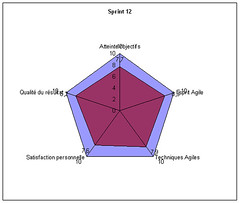To my question “how can we demonstrate the validity of Agile using figures” the disappointing conclusion was that it was not actually possible (thank you Jamie and your “when you know, you know” ;-) ). For more on this, I’d like to refer you to the presentation Agile – Les chiffres pour convaincre (The Figures that Make a Convincing Case for Agile) from XP Day Paris, as well as the book Lean Software Development – An Agile Toolkit. These two documents explain how you can make more money when using Agile methods. This is not proving the validity of Agile from an engineering point of view, but it should still help!
Concerning measuring the ‘agile-ness’ of a team, Rachel Davies shown that she likes to identify the Agile practices that a team should use (such as Continuous Integration), and then give a mark from 0 to 10. If a team is given less than 10, she also adds what is missing to reach the highest mark (“the CI should run integration tests”). I must admit that, though simple to put in place, I am rather sceptical of this approach. It seems to ignore the fact that a truly Agile team should always try to do better, regardless of whatever mark they got.
One option presented at XP Day might help: the idea is to ask team members, at each iteration retrospective, to evaluate themselves their agile-ness on a 0 to 5 scale. After adding questions such as “how happy are you on this project?” and “how well do you feel we responded to business needs”, you end up with a good-looking radar chart that evolves in time. This is very appealing: it helps keep Agile in the mind of the team members, become more autonomous (no waiting for an external consultant to tell them the gospel), prevent the “checkbox list effect”… plus, it’s cheap to put in place!
My hand-written notes taken live are available in the Book of Proceedings.

